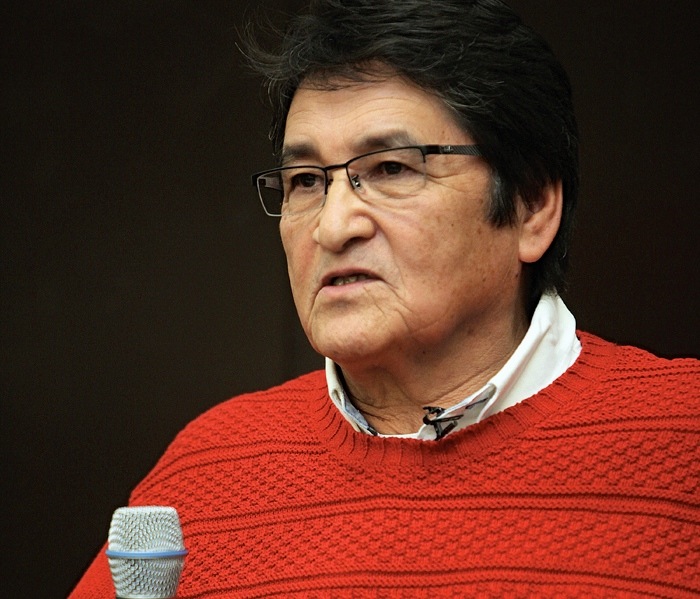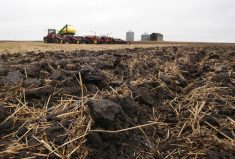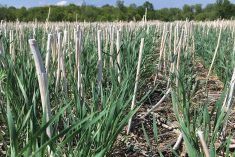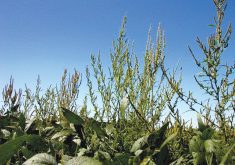When James Wilson asks an auditorium of agriculture students how many First Nations farmers they know, only two hands go up.
That doesn’t surprise Manitoba’s treaty commissioner.
“It’s not by accident,” he said, explaining that for decades policies enacted by the federal government made it impossible for Aboriginal people to farm successfully.
But that’s not how things began.
As European settlers moved into what would become Western Canada, a series of numbered treaties were entered that gave both First Nations and newcomers rights. Agriculture was central to the negotiation of these agreements.
“Farming and agriculture at one time in Canada, and here in Manitoba, was seen as a vehicle and a means to adapt to change, and contribute to the Canadian economy. That was a significant part of the treaty process,” Wilson told a recent forum at the University of Manitoba.
Cultivation was already important to Aboriginal people, who had been growing crops like corn, lamb’s quarters, amaranth, beans and squash for hundreds and even thousands of years. But as the Prairies changed and new technologies arrived, First Nations saw agricultural expansion as key to the future.
In the Virden area in particular, which is encompassed by Treaty No. 2, First Nations farming took off with great success.
“But through directed government policy… it hasn’t become what was once envisioned,” Wilson said.
Read Also

Precision 4R cuts farm greenhouse gas emissions
Lower areas in your field tend to emit more greenhouse gas, research shows that precision 4R nutrient stewardship practices can help mute the trend
- From AgCanada.com: Indigenous ag summit cultivates local ambition
Unilateral act
That directed government policy began with the Indian Act, first passed in 1876.
“The first evidence of bigotry in this country was in that document,” former national chief of the Assembly of First Nations told the students.
While treaties had been negotiated between nations, Ovide Mercredi explained that the Indian Act was passed unilaterally by a white parliament and allowed any government policy to be imposed upon First Nations.
“The treaty was to guarantee our people a relationship with the Crown, where we would live with peace and harmony with the settlers who were coming into our lands and sharing our territories,” he emphasized. “It’s really a treaty of peace, not a treaty of extinguishment, it’s a treaty relationship where we would grow together, not a treaty where one party would dominate the other and dictate to the other what they can or cannot do.”
But Mercredi said even before the ink was dry, there was disagreement over what the treaties meant, and rights believed to be enshrined in the multilateral agreements were then usurped by a paternalistic and damaging Indian Act.
That contentious legislation paved the way for residential schools, outlawed indigenous religions, restricted the movements of Aboriginal people, disenfranchised them, and prevented them from seeking legal remediation against the Crown. It also stopped First Nations people from establishing themselves as farmers by allowing for a series of massively detrimental government policies to be enacted.
Labour-saving equipment banned
“It’s easy for us in 2015 to look back and say, ‘that was so stupid,’ but the thinking behind these government policies was that Christianity and civilization were one and the same, so the government wanted to civilize First Nations people, Christianize First Nations people through policy,” Wilson said. “One of the policies it then implemented was called the Peasant Farmer Policy, and this has a lot to do with the crippling of First Nations farming.”
That policy, introduced in 1889, outlawed labour-saving farm equipment on First Nations farms, preventing any type of mechanization.
“First Nations could only farm with handmade tools,” said the commissioner, explaining that the policy stemmed from archaic ideas about progress and the notion that people could not become civilized without progressing through the same stages as Europeans had.
One of those stages was intensive manual labour.
However, Mercredi points to another motivating factor in preventing First Nations from becoming successful agriculturalists.
“The resistance to Indian agriculture came from white farmers and the provinces. I’m not speculating… I challenge you to do the research,” he said, explaining that those with competing interests lobbied the federal government to protect their own endeavours.
And if indigenous farmers did manage to produce a surplus in spite of the onerous barriers placed on them, they were prohibited from selling their goods outside of their own reserve following the introduction of a pass and permit system in the late 1880s. Some elements of that system remained in the Indian Act until 1995.
Outside of broad policies, many failures to fulfil obligations and broken promises by various levels of governments have also stymied First Nations farming.
But as First Nations continue to fight for the fulfilment of their treaty rights, including the right to agriculture, these are issues this generation and the next will have to contend with, Mercredi said.
However, the Aboriginal and non-Aboriginal farmers do have some common ground from which to find a way forward.
“The farmers and my people have something in common, we appreciate the land and we live off the land, we respect the land,” Mercredi said. “So it’s not as if we’re miles apart.”




















